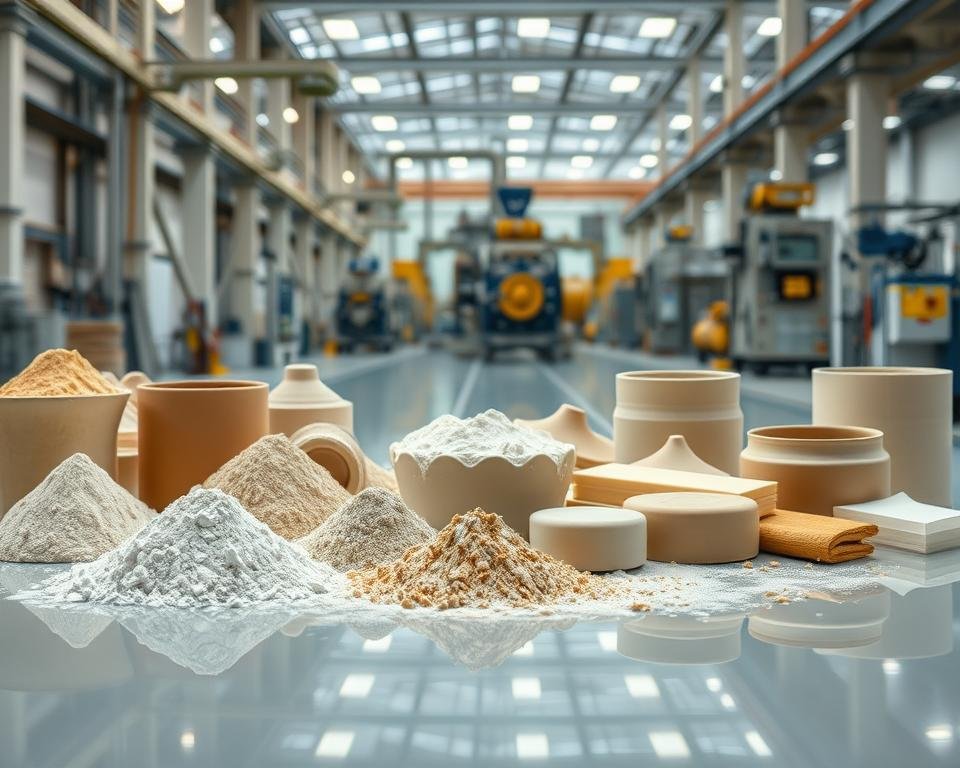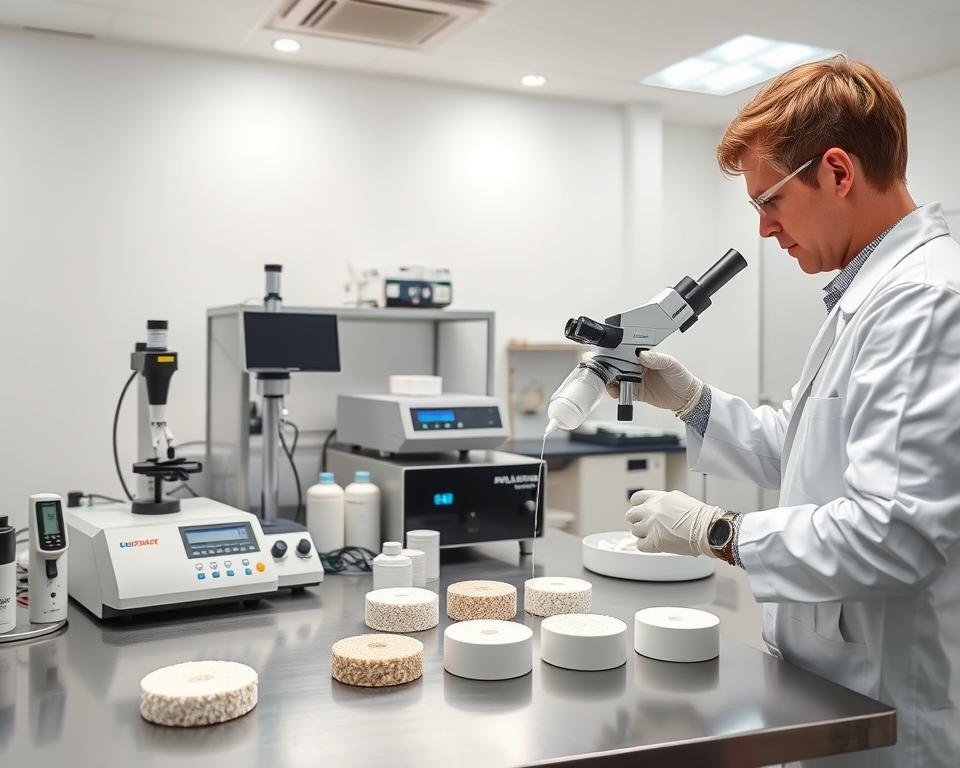If you love working with clay, you know it can be tough. Did you know the right deflocculant can boost your ceramic pieces’ quality by up to 30%? This shows how important deflocculants are for making ceramics great.
I’ll show you the world of deflocculants. We’ll look at their benefits and how to use them in your ceramic work. By the end, you’ll know how to make your ceramic projects even better.
Key Takeaways
- Understand the role of deflocculants in ceramic production
- Learn how to choose the right deflocculant for your ceramic needs
- Discover how to incorporate deflocculants into your process
- Troubleshoot common issues with deflocculants
- Improve the quality of your ceramic pieces
Understanding Deflocculants and Their Role in Ceramics
Learning about deflocculants is essential for making ceramics. They are key in the ceramics world, affecting how easy it is to work with and the quality of the final product. We will look into what deflocculants are, their types, and the science behind them.
What are Deflocculants?
Deflocculants are chemicals that help make ceramic slurries stable and thinner. They reduce the stickiness between particles, stopping clumps from forming. This makes the mixture flow better, leading to a uniform texture in the final product.
Types of Deflocculants
There are many types of deflocculants for ceramics, each with its own uses and benefits. Some well-known ones are:
- Polyelectrolytes: These are long-chain polymers that work well in small amounts.
- Sodium Silicate: A common deflocculant used in many ceramic projects.
- Acrylic-based Deflocculants: Known for their wide use and effectiveness in different ceramic mixes.
The Science Behind Deflocculation
The science of deflocculation involves changing how particles in the slurry interact. Deflocculants adjust the electric charges on particles, making them less attracted to each other. This makes the slurry more stable and easier to work with.
The DLVO theory helps explain these interactions. By understanding this science, ceramic makers can pick the right deflocculants. This improves their work and the quality of their products.
Benefits of Using Deflocculants in Ceramic Production
Deflocculants are key in making ceramics better and more efficient. They help ceramic artists and makers get better results. This includes easier work, better texture, and saving money.
Improved Workability
Deflocculants make ceramics easier to work with. They make the ceramic mix less thick, so it’s simpler to shape. This is great for ceramic manufacturing because it makes the process smoother.
With deflocculants, artists can make their materials more consistent. This means they can control their work better. It leads to better quality and less waste, helping the environment.
Enhanced Texture and Finish
Deflocculants also make ceramics look better. They spread out the particles in the mix, making the surface smoother. This is important for things that need to look good.
They help create detailed and fancy finishes. This is great for both useful items and decorations. The better look and feel of ceramics can make them more valuable.
Cost Efficiency
Deflocculants also save money in making ceramics. They use less material and waste less, which cuts costs. This is big for big ceramic manufacturing jobs where materials are expensive.
They also make making ceramics faster. This means you can make more and save money. Deflocculants are good for makers who want to save money and help the planet.
How to Choose the Right Deflocculant for Ceramics
Choosing the right deflocculant is key for great ceramic quality. There are many options, so knowing what to look for is important.
Key Factors to Consider
When picking a deflocculant, think about your clay type, mix consistency, and the environment. For example, some clays need a certain deflocculant for the right mix.
- Type of Clay: Each clay is different. Knowing its needs is vital.
- Desired Consistency: The deflocculant should make your mix just right, without harming the ceramic.
- Environmental Considerations: Eco-friendly deflocculants are becoming more popular due to environmental concerns.
By looking at these points, you can find the perfect deflocculant for your project.
Popular Deflocculants for Ceramic Applications
Many deflocculants are used in ceramics, each with its own benefits. Here are a few:
- Sodium Silicate: It makes ceramic slips flow better.
- Darvan: It’s known for improving ceramic stability.
- Polyacrylates: These synthetic deflocculants work well in many ceramic uses.
Knowing the good and bad of these deflocculants helps you choose wisely. For instance, sodium silicate works well but might not fit all clay types.
The right deflocculant can really improve your ceramic work. By considering the important factors and knowing about popular deflocculants, you can get the best results for your project.
The Process of Incorporating Deflocculants
Choosing the right deflocculant is just the first step. Next, you need to mix it into your ceramic mixture well. This process has several key steps that affect your ceramics’ quality.
Calculating the Right Amount
Getting the right amount of deflocculant is key to improving ceramic properties. Too little, and it won’t work as expected. Too much, and it can cause problems. Start with a small amount and add more until you get the right consistency.
Begin with the amount suggested by the manufacturer for your clay. As you get more experience, adjust it based on your clay and project needs.

Mixing Techniques
The way you mix the deflocculant into your ceramic mixture matters a lot. It’s important to mix it well so it works evenly. Add the deflocculant slowly while stirring hard.
John Smith, a famous ceramicist, said, “Good mixing is key to deflocculation. Make sure the deflocculant is fully mixed and the mixture is even.” Use a mixer or manual stirring for small batches.
Timing and Application
When to add the deflocculant is also important. Sometimes, adding it at the start works best. Other times, adding it later is better. The best time depends on your clay and the deflocculant types you use.
“The timing of deflocculant addition can make a significant difference in the final product. Experimenting with different timings can help you find what works best for your specific application.”
To get the most out of your deflocculant, think about your whole ceramic-making process. Improve each step, from mixing to firing, to get the best results and better ceramics.
Common Challenges When Using Deflocculants
Using deflocculants in ceramics can face challenges like over- and under-deflocculation. These problems can affect the quality of the final product. It’s important to know how to spot and fix these issues.
Over-deflocculation and Its Effects
Too much deflocculant makes the ceramic mixture too runny. This weakens the structure and reduces durability. Signs include a very fluid mix or excessive settling.
To fix it, you can use less deflocculant or add more ceramic material. This helps get the right consistency.
Under-deflocculation: Signs and Remedies
Not enough deflocculant makes the mix too thick. This makes it hard to achieve a smooth finish. Signs are a thick, clay-like mix that’s hard to pour or cast.
To solve this, add small amounts of deflocculant slowly. Watch the mix’s viscosity until it’s just right.
Knowing how to handle these challenges is vital for using deflocculants effectively. Being aware of these issues and how to fix them helps in making ceramics more efficiently and sustainably.
Testing and Evaluating Deflocculant Efficiency
To make sure your ceramic mix is just right, you need to test the deflocculant. Deflocculants help get the mix to the perfect consistency and workability. They are key to the quality of your final product, so testing them often is a must.

Methods for Testing Viscosity
Viscosity is very important in making ceramics. It affects how the glaze or slip looks and works. You can use a viscometer to check viscosity. This tool shows how hard it is for the mix to flow.
There are different viscometers for different ceramic mixes. Always follow the maker’s guide and keep the mix at the same temperature. This helps you get the right consistency by adjusting the deflocculant.
Visual Assessment of Ceramic Mixes
Looking at the mix can also tell you a lot. A good mix should be smooth and even, without lumps. It should also flow well when you move it with a spatula or brush.
While looking at the mix can be a bit tricky, it’s even better when you do it with viscosity tests. This way, you get a full picture of your mix’s quality. Regular testing helps make your ceramic work more stable and consistent, leading to better results.
Safety Considerations When Handling Deflocculants
When working with deflocculants in ceramic production, safety comes first. These chemicals help make ceramic materials easier to work with. But, they can be dangerous if not handled correctly.
Proper Handling and Storage
It’s important to follow the manufacturer’s guidelines for deflocculants. This means knowing the right amount to use and any safety steps to take. Proper storage is also key; keep deflocculants in a cool, dry spot, away from harmful materials.
Here’s how to store deflocculants safely:
- Keep containers tightly sealed
- Label containers clearly with the contents and any relevant hazard warnings
- Store in a well-ventilated area to prevent the accumulation of potentially hazardous fumes
Safety Gear and Precautions
Wearing the right safety gear is critical when handling deflocculants. This includes gloves, safety glasses, and a dust mask or respirator, based on the deflocculant and the task.
Some important safety steps include:
| Precaution | Description |
|---|---|
| Avoid skin contact | Deflocculants can irritate the skin; gloves are a must. |
| Use in well-ventilated areas | This prevents inhaling harmful dust or fumes. |
| Follow manufacturer’s instructions | Each deflocculant has specific safe use guidelines. |
By focusing on safety and following precautions, ceramic producers can reduce risks. This makes the workplace safer and helps in sustainable ceramic production.
Innovations in Deflocculant Technology
Deflocculant technology has made big strides, opening up new options for ceramic artists and makers. These advancements are not just making ceramics better. They’re also making the making process more efficient.
Advancements in Deflocculant Formulations
New deflocculant formulas have been developed. They work better at lower doses, cutting costs and environmental harm. Some are even made from renewable sources, making them greener for producers.
Key benefits of new deflocculant formulations include:
- Improved dispersion stability
- Enhanced flow characteristics
- Reduced settling rates
The table below shows some recent deflocculant tech advancements and their benefits:
| Deflocculant Type | Application | Benefits |
|---|---|---|
| Polymer-based | Ceramic slips and glazes | Improved stability, reduced viscosity |
| Bio-based | Eco-friendly ceramic production | Sustainable, lower environmental impact |
| Nano-particle | Specialty ceramics | Enhanced mechanical properties |
Environmental Considerations
Nowadays, making deflocculants is all about being green. Makers are working on products that are good for the planet and work well. They’re using stuff that breaks down easily and avoiding bad chemicals.
The move towards green deflocculants is a big step for sustainable ceramics. As things keep changing, we’ll see more cool ways to be eco-friendly and effective at the same time.
Case Studies: Successful Deflocculant Application
Many case studies show how deflocculants change ceramic manufacturing. These examples give us insights into the challenges and chances that deflocculants bring to the ceramic world.
Examples from the Ceramic Industry
Several case studies show deflocculants working well in ceramics. For example, a study in an academic journal found that deflocculants made ceramic slips easier to work with. This led to a more even final product.
Using deflocculants in ceramics has many benefits:
- Improved workability: Deflocculants make ceramic slips less thick, making them simpler to shape.
- Enhanced texture and finish: The right amount of deflocculant can give products a better texture and look.
- Cost efficiency: Using deflocculants well can cut down on waste and lower costs.
Lessons Learned from Failures
Not every case study is a success. Some makers have run into problems with deflocculants, like too much or too little. These issues teach us important lessons.
Too much deflocculant can make the ceramic mix unstable, causing problems during firing. Too little makes the slip too thick, hard to shape.
By looking at these studies, makers can learn how to use deflocculants better. They can also avoid common mistakes.
Expert Tips for Optimal Deflocculant Use
Learning how to use deflocculants well can make ceramics better and greener. Knowing how to apply deflocculants can help makers improve their work. They can also get more consistent results.
Insider Techniques from Industry Professionals
Experts say proper mixing techniques are key when adding deflocculants to ceramic slips. A well-mixed slip makes the ceramic work better and look nicer. For more on deflocculation, check out Digital Fire’s article.
It’s also important to monitor the viscosity of the slip. Adjusting the deflocculant amount helps get the right consistency. This makes the product better and helps the environment by using less material.
Common Mistakes to Avoid
One big mistake is over-deflocculation. This makes the slip too thin, weakening the final product. To fix this, producers need to measure and adjust the deflocculant carefully.
Not thinking about the environmental impact of deflocculants is another error. Choosing eco-friendly deflocculants can lessen the ceramic production’s harm to the planet. This supports the trend towards sustainable practices in making things.
By using these tips and avoiding mistakes, ceramic makers can improve their processes. This leads to better products and greener ways of making them. It’s good for the makers and helps the whole ceramic industry grow.
Conclusion: Mastering Deflocculant Use for Ceramic Success
Deflocculants are key to making ceramics better and more efficient. They help improve the stability and quality of ceramics. By knowing how to use different types of deflocculants, artists and manufacturers can make their work better.
We’ve talked about how deflocculants make ceramics easier to work with. They also make the texture and finish better and save money. It’s important to pick the right deflocculant, use the right amount, and apply it correctly.
Key Takeaways and Future Innovations
This guide has given you the tools to try new things with deflocculants. As you keep working with them, you’ll find new ways to improve your ceramics. You’ll be able to make your craft even better.
Using what you’ve learned, you’ll get better at using deflocculants. This will help you make high-quality ceramics. Whether you’re experienced or just starting, using deflocculants well will show off your talent and creativity.
